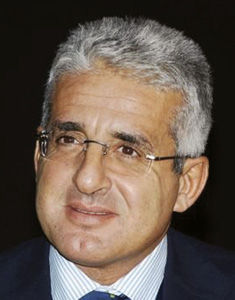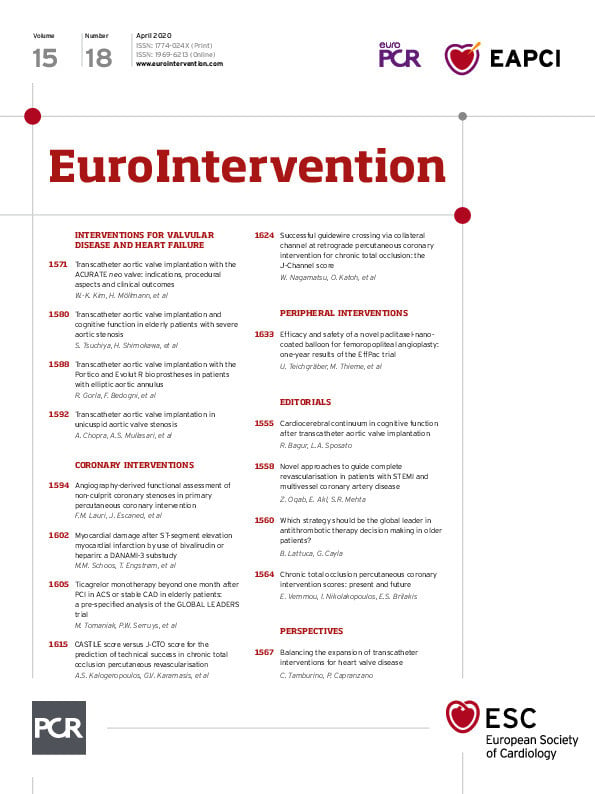
The field of transcatheter repair and replacement procedures has grown exponentially in the last decade, dramatically changing the evaluation and management of patients with valvular heart disease (VHD). Transcatheter aortic valve implantation (TAVI) has revolutionised the treatment of patients affected by symptomatic severe aortic stenosis with higher operative risk. In 2019, based on two recent dedicated randomised trials, TAVI also obtained regulatory approval for lower-risk populations, thus widening the pool of patients eligible to this less invasive treatment1. Transcatheter repair of mitral regurgitation (MR) with the edge-to-edge MitraClip® device (Abbott Vascular, Santa Clara, CA, USA) has recently achieved an extension of indications based on new randomised evidence showing superior outcomes of this treatment compared with optimal medical therapy in patients with secondary MR2. Several percutaneous approaches for MR repair are in different stages of clinical development, offering options for an array of mitral valve abnormalities. In addition, devices for transcatheter mitral valve replacement are under clinical investigation to offer treatment options to high-risk patients unsuitable for repair techniques. Finally, percutaneous interventions for tricuspid valve are being developed for patients with high surgical risk. Collectively, the progressively growing number of candidates and the wider clinical indications for VHD transcatheter therapeutic options are leading to their rapid expansion. While relentless, this should be well oriented and balanced. In particular, refinements in the treatment selection process by the Heart Team (HT), emphasis on specific training, implementation of optimised systems of care for VHD and further patient-centred research are all needed in the expansion phase of the field of transcatheter heart valve interventions.
Transcatheter VHD intervention programmes are based on the essential joint collaboration between the disciplines of interventional cardiology and cardiac surgery, the co-directors of which are coordinators of the overall multidisciplinary HT3. Currently, due the increased number of both percutaneous and surgical treatment options for VHD and the higher complexity of the decision-making process, a multidisciplinary assessment and management is even more important for the optimal care of VHD patients. Indeed, recent advances in the field of VHD treatment reinforce the need for shared therapeutic choices based on different expert viewpoints, a common balanced informed consent on all options, comprehensive knowledge of VHD, complete technical skill sets, continuous consultation and optimal complication management, all aspects that only a multidisciplinary HT is able to guarantee. Thus, while the basic principles remain unchanged but are instead emphasised, the decision-making processes and the composition of the HT require adaptation based on the emerging evidence. A revision of the HT decision-making process is particularly needed for the treatment of aortic stenosis as a result of evidence derived from two recent randomised trials comparing transfemoral TAVI with surgical aortic valve replacement (SAVR) in patients at low surgical risk showing similar mortality and stroke up to two-year follow-up. An updated meta-analysis, including 8,020 patients with severe, symptomatic aortic stenosis from the seven randomised trials comparing TAVI versus SAVR in patients at high, intermediate, and low risk, showed that TAVI was associated with 12% and 19% relative risk reductions of two-year all-cause death and stroke, respectively, regardless of baseline surgical risk1. The observation of consistently favourable outcomes of TAVI across the entire risk spectrum suggests that surgical risk estimation is no longer the basis for the choice between TAVI and SAVR, as it has been until now. Currently, there is no surgeon as gatekeeper selecting TAVI in bad candidates for surgery. Instead, the current HT has to weigh several clinical and anatomic characteristics to identify the best treatment option for the individual patient (TAVI or SAVR or medical therapy). Considering the clinical (i.e., age, general clinical status, quality of life, frailty, comorbidities, other valves diseases, surgery impediments) and anatomical (i.e., femoral access status, aortic root morphology, size of aortic annulus, aortic valve morphology, concomitant coronary artery disease, coronary ostia origins, concomitant aortopathy) variables to be assessed in selecting the treatment for aortic stenosis, several HT members from different specialties (clinical cardiologist, cardiac imaging specialist, cardiac anaesthesiologist, and other medical specialists) continue to play a key role in this novel decision-making process. While the composition of the HT for aortic stenosis remains substantially unchanged, for the treatment of MR it becomes crucial to include the active participation of heart failure and mitral imaging specialists4. Indeed, evidence derived from randomised trials has shown that for functional MR the MitraClip device offers additional clinical benefits to optimal medical therapy in selected symptomatic patients with the strict echocardiographic criteria adopted in the COAPT trial2. Thus, the right clinical patient selection for MitraClip implantation is essential for the effectiveness of this treatment. Regarding decision making for MR treatment, assessment of surgical risk by the HT remains the basis4. Thus, with some adaptation, the multidisciplinary approach guided by the surgeon and the interventional cardiologist coordinating different partnerships remains the essential mainstay of any successful catheter-based VHD therapy implementation.
Another strategic element for tackling the challenges related to the expansion of transcatheter intervention is to make efforts to improve training. Valve heart centres are responsible for providing a structured environment for training and proctoring, with more formalised and standardised programmmes for new operators in VHD interventions. Apart from the operators performing VHD interventions being instructed in patient and device selection along with technical and procedural aspects, it is of particular importance to enhance the training in structural heart disease imaging. The imaging specialist is an integral member of the HT with expertise in cardiovascular imaging (either single modality or multimodality), skilled in advanced techniques. Indeed, non-invasive multimodality imaging (2-dimensional [2D] and 3-dimensional [3D] echocardiography, in addition to multislice computed tomography [MSCT] and cardiac magnetic resonance imaging) provides essential data for the diagnosis of significant VHD, to establish the indication for interventions, select the best treatment, plan the interventional procedure, and predict the potential procedural risks and complications. The success of an intervention begins with the correct indication for it which is mainly established by imaging-derived information. Moreover, imaging criteria for accurate device choice and for prediction of complications are key for optimised outcomes. To determine these latter procedural aspects better, novel imaging approaches such as 3D printing of patient-specific models from data acquired from MSCT and transoesophageal echocardiograms (TOE) can be useful5. Besides having a role in preprocedural assessment and planning, the valve imaging specialist has to have proficiency in guiding the procedural steps. Specific training guidelines, scientific society certification and dedicated fellowships for this new interventional echocardiography subspecialty are warranted. Also, considering the relevant time needed to conduct all the work of the preprocedural and intraprocedural phases, valve centres should plan to provide additional staff dedicated solely to interventional echocardiography.
In general, the potentially increasing number of transcatheter VHD interventions demands some hospital logistic refinements. The organisation of the valve heart centre structure should be based on the principle of maintaining excellent levels of expertise and quality in the management of VHD while providing patients with adequate access to care. This might require a reallocation of economic, personnel and time resources, potentially leading to centres focusing only on structural heart disease care programmes, if logistically possible within the local network. Also, current resource constraints in healthcare, along with the need to provide increasingly timely access to care, highlight the importance of the imperative implementation of minimalist pathways, including early discharge, in the management of VHD patients. Beyond the individual hospital logistic, it is time to organise regional or national valve network systems of care including centres with defined standards criteria to guarantee the highest quality of care3,4. A recent consensus has proposed a network model based on a two-tier valve centre system6. The primary heart valve centres would be capable of performing isolated SAVR and less complex surgical mitral valve repair, as well as transfemoral TAVI and balloon aortic valvuloplasty. The second-tier centres would be more advanced and thus perform the complete range of surgical and transcatheter structural heart interventions. This proposal may not fit some healthcare systems but, whatever the adapted model, it is crucial to provide access to the full spectrum of interventions with patients and referring physicians being aware of the specific centre structure, expertise, volumes, services and processes and outcomes. Referring and post-procedural management pathways should be clearly defined for the specific geographic area. Also, valve centres should establish criteria for communication, feedback, collaboration, and transfer within the network. Finally, and most importantly, in parallel to clinical care, valve heart centres should create a research network by participation in large registries and focused studies to address currently unresolved patient-centred questions on VHD management and treatment, to define better the best treatment selection criteria, minimise complications and improve clinical and patient-reported outcomes. Indeed, these latter are the basic principles for a healthy and balanced growth in the field of transcatheter VHD interventions.
Conflict of interest statement
The authors have no conflicts of interest to declare
Supplementary data
To read the full content of this article, please download the PDF.

